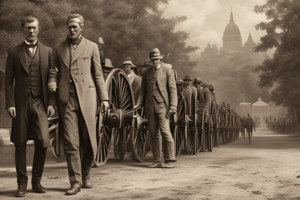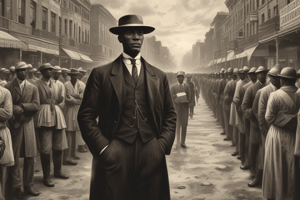Podcast
Questions and Answers
What was a key goal of Reconstruction?
What was a key goal of Reconstruction?
- Rebuilding the South and integrating freed slaves into society (correct)
- Limiting the power of the federal government
- Establishing monarchies in the South
- Expansion of the western territories
The Fourteenth Amendment granted African American men the right to vote.
The Fourteenth Amendment granted African American men the right to vote.
False (B)
Who opposed President Johnson's Reconstruction plan?
Who opposed President Johnson's Reconstruction plan?
Republicans in Congress
The __________ was a white supremacist group that emerged during Reconstruction.
The __________ was a white supremacist group that emerged during Reconstruction.
Match the amendments with their descriptions:
Match the amendments with their descriptions:
What hindered the progress of Reconstruction in the South?
What hindered the progress of Reconstruction in the South?
Reconstruction governments were effective in fully integrating African Americans into Southern society.
Reconstruction governments were effective in fully integrating African Americans into Southern society.
What were the main challenges faced during the Reconstruction period in the South?
What were the main challenges faced during the Reconstruction period in the South?
Match the following key terms to their descriptions related to Reconstruction:
Match the following key terms to their descriptions related to Reconstruction:
Match the following amendments to their significance:
Match the following amendments to their significance:
Match the following components of President Johnson's Reconstruction Plan with their features:
Match the following components of President Johnson's Reconstruction Plan with their features:
Match the challenges faced by African Americans during Reconstruction:
Match the challenges faced by African Americans during Reconstruction:
Match the key events in Congressional Reconstruction with their outcomes:
Match the key events in Congressional Reconstruction with their outcomes:
Match the following Southern responses to Reconstruction policies:
Match the following Southern responses to Reconstruction policies:
Match the Reconstruction goals with their intended purpose:
Match the Reconstruction goals with their intended purpose:
Match the following historical figures with their contributions during Reconstruction:
Match the following historical figures with their contributions during Reconstruction:
Flashcards are hidden until you start studying
Study Notes
Reconstruction Overview
- Aimed to address the issues following the Civil War and rebuild the nation.
- The success of Reconstruction remains debated regarding its goals for racial equality and reintegration of Southern states.
Rebuilding the South
- Reconstruction begins with various initiatives to restore the South and integrate it back into the Union.
- African Americans gain freedom through legislative and military efforts, but challenges persist.
- President Johnson's Reconstruction Plan emphasizes leniency towards the South but faces criticism for being too forgiving.
The Fight over Reconstruction
- Pre-war Southern leaders regain power, prompting conflict with Republican Congress members.
- Opposition to President Johnson grows as his policies clash with Republican goals for stronger civil rights protections.
- The Fourteenth Amendment is ratified, granting citizenship and equal protection under the law to all persons born or naturalized in the U.S.
- Congress asserts control over Reconstruction efforts, highlighting tensions between branches of government.
- The Fifteenth Amendment is passed, prohibiting voter discrimination based on race, thus granting African American men the right to vote.
Reconstruction in the South
- Reconstruction governments establish laws and policies to promote civil rights and rebuild infrastructure.
- The rise of the Ku Klux Klan signifies growing violence and resistance against African American rights and Reconstruction policies.
- Reconstruction officially ends with compromises and shifts in political power, leading to segregationist policies.
- Economic efforts focus on rebuilding Southern industry, although many regions remain impoverished.
- Reconstruction's legacy in the North reflects a mixed response to the changes occurring in Southern society and race relations.
Reconstruction Overview
- Reconstruction aimed to address the myriad of challenges faced in reuniting and rebuilding the nation after the Civil War.
- Key issues included re-integrating Southern states, defining citizenship rights for freed slaves, and restoring the economy.
Freedom for African Americans
- The period marked significant shifts in social dynamics, particularly for African Americans, who gained legal rights through amendments.
- Efforts included the establishment of schools for freed slaves and initiatives to acquire land, although results varied widely.
President Johnson's Reconstruction Plan
- Johnson's plan was lenient towards the South, focusing on rapid restoration of states rather than ensuring civil rights for African Americans.
- The plan faced strong opposition from Radical Republicans in Congress, who felt it undermined the achievements of the war.
Opposition to President Johnson
- Johnson faced severe backlash from Congress due to his lenient measures and failure to enforce civil rights protections.
- This conflict ultimately led to Johnson's impeachment, highlighting deep political divisions during Reconstruction.
Fourteenth Amendment
- Ratified in 1868, it granted citizenship to all persons born or naturalized in the U.S. and ensured equal protection under the law.
- It aimed to curb the power of Southern states to disenfranchise African Americans and reinforced the federal government’s role in protecting rights.
Congress Takes Control of Reconstruction
- Congress, led by Radical Republicans, assumed control over Reconstruction, introducing more stringent measures to ensure civil rights and rebuilding efforts.
- This included military enforcement in the South to maintain order and protect freedmen's rights.
Fifteenth Amendment
- Ratified in 1870, it prohibited denying the right to vote based on race, color, or previous condition of servitude.
- Despite this, various discriminatory tactics, such as literacy tests and poll taxes, emerged to suppress African American voting.
Reconstruction Governments
- Southern states implemented new governments aimed at integrating freedmen into political life, although they often faced violent opposition.
- The dynamics created a tumultuous political landscape, with African Americans participating in governance for the first time.
Ku Klux Klan
- This secretive organization emerged as a violent reaction to Reconstruction efforts, targeting African Americans and their allies.
- The Klan employed intimidation and violence to undermine African American civil rights and disrupt Reconstruction efforts.
Reconstruction Ends
- As federal troops withdrew from the South, the progress made during Reconstruction faced severe backlash, leading to the rise of Jim Crow laws and segregation.
- The end of Reconstruction marked a significant setback for African American rights, reversing many gains achieved in the preceding years.
Rebuilding Southern Industry
- Efforts to revitalize the Southern economy included promoting new industries and infrastructure but often prioritized the interests of white landowners.
- Sharecropping became prevalent, trapping many African Americans in cycles of debt and poverty.
Reconstruction in the North
- The North witnessed a shift in political focus post-Reconstruction, with industrial growth and immigration reshaping its social landscape.
- However, the legacy of Reconstruction continued to influence Northern attitudes toward race and civil rights activists in the years to follow.
Studying That Suits You
Use AI to generate personalized quizzes and flashcards to suit your learning preferences.




